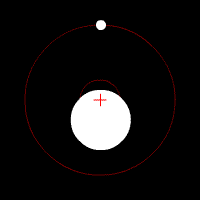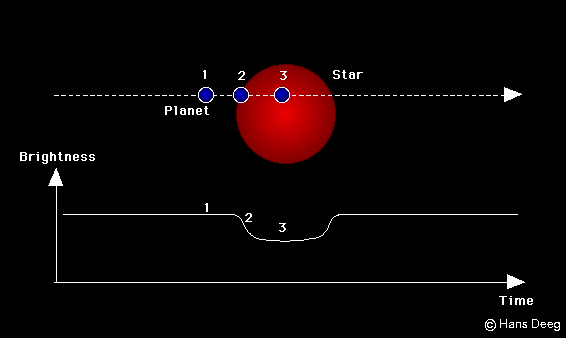It's 11:22 pm and I have been in the library for a while. Today was the first real day of SURF for me, when I actually sat down to think through the project. It was quite amazing, reading about the stars we could look at and trying to reason through which ones were more interesting - more probable to have multiple companion planets. Tomorrow I will have think about it some more. :)
But I jump ahead. Let me give a short overview of the methods we use to discover exoplanets. Currently ignoring the mostly unconfirmed Kepler Field planets, announced back in February, there are about 500 identified extrasolar planets, orbiting stars near and far (but mostly relatively close). The problem in finding exoplanets directly is obvious - the light from their sun will be generally more than a million times brighter, and it is extremely difficult to detect such a faint light source. There are some advances, by blocking starlight and interferometry, but indirect methods have proven much more effective at finding exoplanets.
Doppler spectroscopy/RV method
The most important involves radial velocity measurements. As a large planet orbits a star, it causes the parent star to wobble slightly as both objects orbit around their center of mass. The radial velocity, the speed of the star in the line of sight with Earth, changes as the star is periodically advancing towards and moving away from us. Small Doppler shifts to the light emitted by the star are detected as tiny red and blue shifts in the stars spectroscopic emission.
An exoplanet orbiting a star, both of which are orbiting their common center of mass.
When the star moves towards us, its spectrum is blueshifted, and when the star moves away from us, it is redshifted. By regularly looking at the spectrum and so measure its velocity, you can see if it moves periodically due to the influence of a companion.
Note that these shifts are tiny - literally one pixel that could be simply noise. So a very perfect template spectrum (we use HIRES' iodine cell, where HIRES is the High Resolution Echelle Spectrometer) must be overlaid against the starlight. It's quite pretty, actually, but very exacting.
The observed radial velocity can be plotted against time, and if fluctuations are periodic (circular orbits give sine waves) we have proof of a companion! Moreover, this technique, but Kepler's third law, gives a minimum mass of the planet. A nice example of 51 Pegasi's radial velocity curve is below.
51 Pegasi b, or Bellerophon, was one of earlier discovered exoplanets, and the prototypical hot Jupiter.
This is a more recent RV curve from Keck for HAT-P-6, with center of mass velocity subtracted, and residuals below it.
The largest limitation of this method is that the actual change in radial velocity is unknown, as the exoplanet is probably not on the same plane as Earth. The mass found is a minimum mass, Msini, where i is the angle of inclination.
Transit method
If a planet actually transits - passes in front of - its parent star, the star will dim by 1/10% to 1%, depending on their relative sizes. This happens pretty rarely, as the planet must be on the same plane, and there are many false positives from things like sunspots. The duration of the transit depends on the semimajor axis and the star's mass. Since the mass and size of the star can be determined from spectroscopy, the transiting planet's size and distance from the star can be calculated. If a transit even happens repeated, once per orbital revolution, it is probably a planet!
The transit affects the apparent brightness of the star.
The first exoplanet, HD 209458 b, discovered by the transit method.
One very nice thing about transits is that atmospheres can be studied, as well as parameters of the planet's surface. HD 209458 b, unofficially Osiris, is known to have an evaporating hydrogen atmosphere conaining oxygen and carbon, as well as possibly water vapor. Last year, it was announced that there was a superstorm with windspeeds of up to 7000 km/hr, by the ESO's Very Large Telescope and spectrography of carbon monoxide gas.
Now, the RV method is used to check the transit method. This summer, the plan is to take additional radial velocity measurements of exoplanets found by transits. With both the transit information and the RV curve, we might find that the systems have more than just the one exoplanet. The hope is for massive, perturbing planets on long-period eccentric orbits, pulling at the RV curve very slowly for a long term trend, which would present a unique opportunity to study the internal density structure and tidal dissipation in the inner transiting planet.
That will be for another day!
see also: Exoplanet







No comments:
Post a Comment